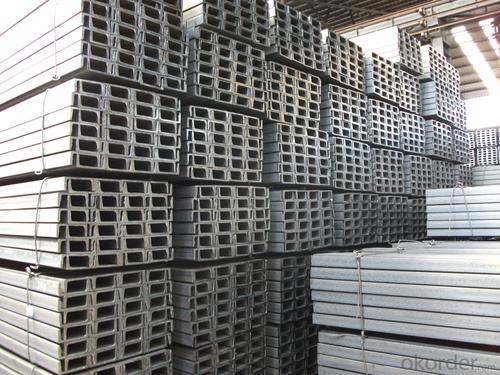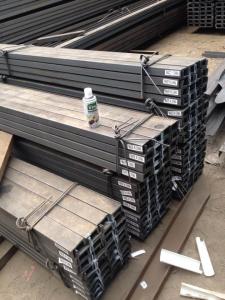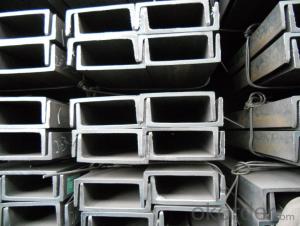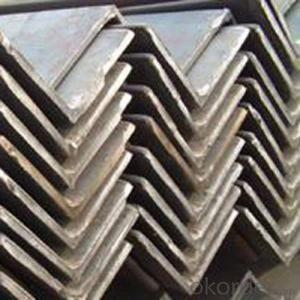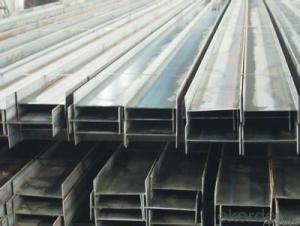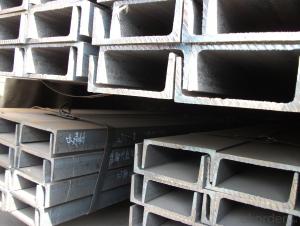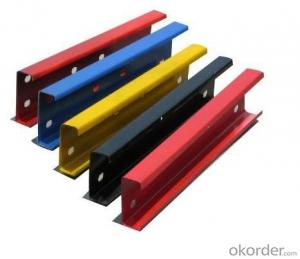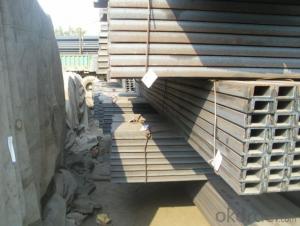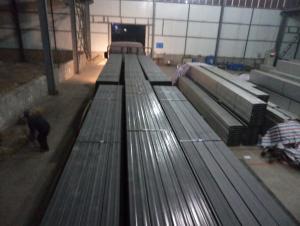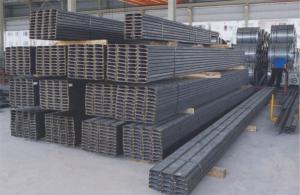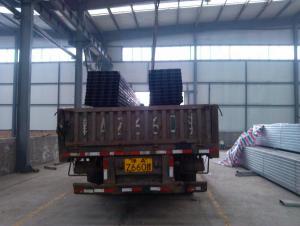Hot Rolled Steel U Channel
- Loading Port:
- China Main Port
- Payment Terms:
- TT or LC
- Min Order Qty:
- -
- Supply Capability:
- -
OKorder Service Pledge
OKorder Financial Service
You Might Also Like
Product Description:
OKorder is offering high quality Channel Steel at great prices with worldwide shipping. Our supplier is a world-class manufacturer of steel, with our products utilized the world over. OKorder annually supplies products to European, North American and Asian markets. We provide quotations within 24 hours of receiving an inquiry and guarantee competitive prices.
Product Applications:
Channel Steel is usually used for building structure, vehicle manufacturing and other industrial structure and often used with i beam.
In details, the channel steel belongs to carbon structural steel which is applied to in the field of construction and machinery. The channel steel is usually used for arch-itechtural structure, and they could be welded in order to support or hang a vari-ety of facilities. They are also usually used in combination with I beam. Generally,the channel steel must possess perfect welding property, riveting property and mechanical property and so on.
Product Advantages:
OKorder's Channel Steel are durable, strong, and resist corrosion.
Main Product Features:
· Premium quality
· Prompt delivery & seaworthy packing (30 days after receiving deposit)
· Corrosion resistance
· Can be recycled and reused
· Mill test certification
· Professional Service
· Competitive pricing
Product Specifications:
| Original Place | Tangshan, China | Brand Name | Bridge |
| Standard | GB707-88, EN100025, JIS G3192, DIN 1026 | ||
| Sizes | 50mm to 300mm | ||
| Sales Volume/Year | 3000MT | ||
| Main Market | Middle East, Africa, Southeast As | ||
1.We are able to provide channel steel of top quality at attractive price.
2.Our products of channel steel have passed ISO9001:2008 Quality Management System Certification.
3. The section of JIS Standard Channel Steel are as followings in the table.
| JIS U CHANNEL | Standard h | Sectional b | Dimension s | t | Mass: Kg/m |
| (mm) | (mm) | (mm) | (mm) | ||
| 50x25 | 50 | 25 | 3.0 | 6.00 | 2.37 |
| 75X40 | 75 | 40 | 3.8 | 7.00 | 5.30 |
| 75X40 | 75 | 40 | 4.0 | 7.00 | 5.60 |
| 75X40 | 75 | 40 | 4.5 | 7.00 | 5.85 |
| 75X40 | 75 | 40 | 5.0 | 7.00 | 6.92 |
| 100X50 | 100 | 50 | 3.8 | 6.00 | 7.30 |
| 100X50 | 100 | 50 | 4.2 | 6.00 | 8.03 |
| 100X50 | 100 | 50 | 4.5 | 7.50 | 8.97 |
| 100X50 | 100 | 50 | 5.0 | 7.50 | 9.36 |
| 125X65 | 125 | 65 | 5.2 | 6.80 | 11.66 |
| 125X65 | 125 | 65 | 5.3 | 6.80 | 12.17 |
| 125X65 | 125 | 65 | 5.5 | 8.00 | 12.91 |
| 125X65 | 125 | 65 | 6.0 | 8.00 | 13.40 |
| 150x75 | 150 | 75 | 5.5 | 7.30 | 14.66 |
| 150x75 | 150 | 75 | 5.7 | 10.00 | 16.71 |
| 150x75 | 150 | 75 | 6.0 | 10.00 | 17.90 |
| 150x75 | 150 | 75 | 6.5 | 10.00 | 18.60 |
4. Chemical Compostion of JIS Standard Channel Steel
| Grade | Element(%) | |||
| C | Mn | P | S | |
| SS330 | -- | -- | ≦0.050 | ≦0.050 |
| SS400 | ||||
| SS490 | ||||
| SS540 | ≦0.30 | ≦1.60 | ≦0.040 | ≦0.040 |
Package & Delivery of Channel Steel:
The steel u channel will be packed in bundle with steel wire at each end of every bundle and color marking in order to help the customer to recognize his goods more easily at sight.
And steel u channel could be loaded into 20ft or 40ft container, or by bulk cargo. If the weight of each bundle reaches less than 3.5 mt, the loading by break bulk cargo should be choosed. When the weight of each bundle reaches less than 3mt, the loading by container should be choosed.
As for the transportaion from mill to loading port, the truck will be usually used. And the maximum quantity for each truck is 40mt.
All in all, we could do in accordance with customer's request.
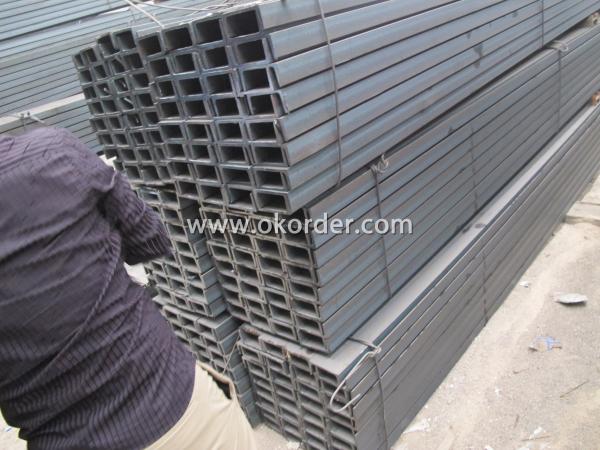
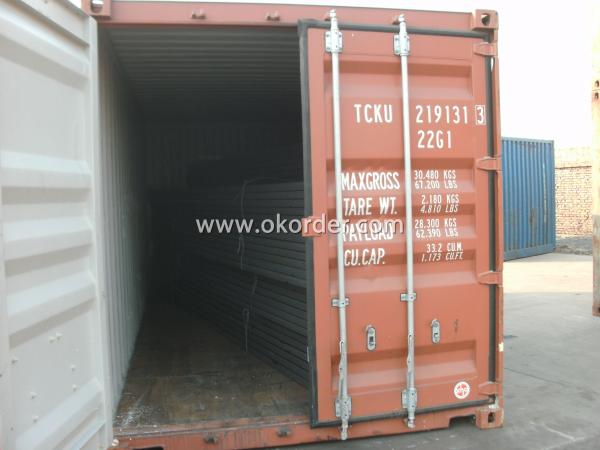
Production Flow of Channel Steel:
1.The steel billet shall be heated in the high temperature furnace.
2. The heated steel billet shall be rolled five to nine times with the aim of shaping the general figure of steel u channel.
3. The rolled steel u channel should be put onto the cooling bed to make the temperature low.
4. The steel u channel should be straighted on the straightener.
5. The straighted steel u channel will be cut into meters by saw, as per customer's requirements.
FAQ:
Q1: Why buy Materials & Equipment from OKorder.com?
A1: All products offered byOKorder.com are carefully selected from China's most reliable manufacturing enterprises. Through its ISO certifications, OKorder.com adheres to the highest standards and a commitment to supply chain safety and customer satisfaction.
Q2: How do we guarantee the quality of our products?
A2: We have established an advanced quality management system which conducts strict quality tests at every step, from raw materials to the final product. At the same time, we provide extensive follow-up service assurances as required.
Q3: How soon can we receive the product after purchase?
A3: Within three days of placing an order, we will begin production. The specific shipping date is dependent upon international and government factors, but is typically 7 to 10 workdays.
- Q: Are steel channels suitable for the power generation industry?
- Yes, steel channels are suitable for the power generation industry. Steel channels offer various advantages that make them a preferred choice for this industry. Firstly, steel channels are known for their high strength and durability. The power generation industry involves heavy machinery and equipment, and steel channels can withstand the weight and stress associated with these operations. They provide structural integrity and stability, ensuring the safe operation of power generation plants. Secondly, steel channels offer excellent corrosion resistance. Many power generation facilities are exposed to harsh environments, such as high temperatures, humidity, and chemicals. Steel channels can withstand these conditions without corroding or deteriorating, prolonging their lifespan and reducing maintenance costs. Moreover, steel channels provide flexibility in design and fabrication. They can be easily customized and fabricated into various shapes and sizes, allowing for efficient installation and integration into power generation systems. This flexibility also enables engineers to optimize the design for specific requirements, enhancing overall efficiency. Furthermore, steel channels have good thermal conductivity. In power generation, heat transfer is a crucial aspect, and steel channels efficiently conduct and distribute heat. This property is particularly important in applications such as heat exchangers and boilers, where efficient heat transfer is critical for optimal performance. Additionally, steel channels offer cost-effectiveness. Steel is a widely available and relatively affordable material, making it a cost-efficient choice for the power generation industry. Furthermore, its durability and low maintenance requirements contribute to long-term cost savings. In conclusion, steel channels are highly suitable for the power generation industry due to their strength, durability, corrosion resistance, flexibility in design and fabrication, thermal conductivity, and cost-effectiveness. These properties make steel channels an ideal choice for various applications within power generation plants, ensuring reliable and efficient operation.
- Q: Can steel channels be used in the renewable energy sector?
- Yes, steel channels can be used in the renewable energy sector. Steel channels are versatile and commonly used structural components that offer strength and durability. They can be used in various applications within the renewable energy sector, such as the construction of solar panel frames, wind turbine towers, and support structures for hydroelectric power plants. In solar energy, steel channels can be utilized in the manufacturing of photovoltaic (PV) panel frames. These frames provide structural support and help maintain the integrity of the solar panels. Steel channels offer the necessary strength to withstand the weight of the panels and external forces like wind and snow loads. Similarly, in the wind energy sector, steel channels can be employed in the construction of wind turbine towers. These towers need to be strong and rigid to withstand the rotational forces from the blades and the dynamic loads caused by wind. Steel channels provide the required structural support and can be easily fabricated into tower sections of varying heights. Moreover, steel channels can also be used in the construction of support structures for hydroelectric power plants. These structures must be able to withstand the weight of the turbines, generators, and other equipment while withstanding the force of flowing water. Steel channels, with their high strength and load-bearing capacity, are well-suited for these applications. Overall, steel channels offer numerous advantages in the renewable energy sector, including their strength, durability, and versatility. Their use can contribute to the development of robust and reliable renewable energy infrastructure.
- Q: Are steel channels suitable for use in telecommunications towers?
- Indeed, telecommunications towers can benefit from the utilization of steel channels. Renowned for their robustness and endurance, steel channels are a perfect choice for bearing substantial burdens and enduring harsh weather conditions. Moreover, the simplicity of fabricating and installing steel channels renders them an economical option when constructing telecommunications towers. Furthermore, they offer exceptional structural stability and can be tailored to meet precise height and load prerequisites. Additionally, steel channels boast an extended lifespan and necessitate minimal upkeep, solidifying their reputation as a dependable selection for telecommunications infrastructure.
- Q: Are steel channels suitable for overhead crane systems?
- Indeed, overhead crane systems find steel channels to be a fitting choice. Given their robustness, longevity, and capacity to withstand substantial weights, steel channels are frequently employed in the assembly of overhead crane systems. They furnish a solid framework for the crane system and can be seamlessly incorporated into its blueprint. Moreover, steel channels can be tailored and modified to fulfill the precise demands of the crane system, encompassing dimensions, load capacity, and span. Ultimately, steel channels provide the indispensable structural support and steadiness required for overhead crane systems.
- Q: How do steel channels contribute to acoustic performance?
- Steel channels can contribute to acoustic performance by providing structural support for soundproofing materials such as insulation or acoustic panels. They help create a barrier that reduces the transmission of sound waves, preventing noise leakage and improving overall acoustic quality within a space.
- Q: Can steel channels be used for raised flooring systems?
- Indeed, raised flooring systems can utilize steel channels. The strength and durability inherent in steel channels render them a highly favorable option for bolstering raised floors. These channels may be arranged in a grid-like fashion, furnishing a sturdy foundation for the raised floor panels. Furthermore, steel channels readily bear heavy burdens, rendering them apt for spaces characterized by extensive foot traffic or equipment setups. Additionally, their resistance to corrosion ensures a prolonged lifespan for raised flooring systems.
- Q: How are steel channels used in the construction of warehouses?
- Steel channels are commonly used in the construction of warehouses to provide structural support. They are used as beams or columns to bear heavy loads and distribute weight evenly throughout the structure. Steel channels also help in creating strong and stable frames, allowing for the construction of large and open spaces within the warehouse. Additionally, they can be used for bracing, reinforcing walls, and supporting overhead doors. Overall, steel channels play a crucial role in ensuring the stability and durability of warehouse structures.
- Q: How do steel channels contribute to building durability?
- Steel channels contribute to building durability in several ways. Firstly, steel channels provide structural support to the building. They are used to create the framework and framework support for floors, walls, and ceilings. This ensures that the building can withstand heavy loads and remain stable over time. Steel channels have high strength and rigidity, making them resistant to bending, warping, and twisting, which ultimately enhances the overall durability of the structure. Secondly, steel channels are highly resistant to corrosion. They are commonly made from galvanized or stainless steel, both of which have excellent resistance to rust and corrosion. This is particularly important in buildings that are exposed to moisture, such as coastal areas or places with high humidity. By using steel channels, the risk of structural damage caused by rust or corrosion is significantly reduced, leading to increased durability of the building. Furthermore, steel channels offer fire resistance. Steel is inherently non-combustible, meaning it does not contribute to the spread of fire. In the event of a fire, steel channels can help contain the flames and prevent them from spreading to other parts of the building. This fire-resistant property significantly improves the safety and durability of the structure. Lastly, steel channels are highly durable and require minimal maintenance. Unlike other building materials that may deteriorate over time, steel channels have a long lifespan and retain their strength and integrity for many years. They are not susceptible to rot, decay, or insect damage, which can be common issues with wood or other organic materials. This durability and low maintenance requirement make steel channels a cost-effective choice in the long run. In conclusion, steel channels contribute to building durability by providing structural support, corrosion resistance, fire resistance, and low maintenance requirements. Their strength, stability, and longevity make them an ideal choice for creating durable and long-lasting buildings.
- Q: Are steel channels suitable for use in the construction of elevated storage systems?
- Yes, steel channels are suitable for use in the construction of elevated storage systems. Steel channels offer several advantages that make them a popular choice for such applications. Firstly, steel channels are known for their high strength and durability. They can withstand heavy loads and provide structural stability, making them ideal for supporting elevated storage systems. Additionally, steel channels have excellent resistance to corrosion, which is crucial in storage systems where exposure to moisture or harsh environmental conditions may occur. Furthermore, steel channels are versatile and can be easily fabricated into various shapes and sizes to meet specific design requirements. This allows for flexibility in constructing storage systems of different dimensions and configurations. Steel channels also offer ease of installation and can be efficiently connected using various methods such as welding or bolting. Another advantage of using steel channels in elevated storage systems is their cost-effectiveness. Steel is a relatively affordable material compared to alternatives like aluminum or composite materials. Additionally, steel channels require minimal maintenance over their lifespan, reducing long-term costs. Overall, the strength, durability, resistance to corrosion, versatility, and cost-effectiveness of steel channels make them highly suitable for use in the construction of elevated storage systems.
- Q: How do steel channels perform in high-impact applications?
- Steel channels are known for their exceptional strength and durability, making them well-suited for high-impact applications. The structural design of steel channels allows them to withstand significant forces, making them highly resistant to bending, twisting, and breaking under intense impacts. In high-impact applications, such as heavy machinery, construction equipment, and automotive parts, steel channels excel due to their ability to absorb and distribute the impact energy evenly throughout their structure. This prevents localized damage and ensures the integrity of the overall system or structure. Additionally, steel channels are capable of maintaining their properties at extremely high temperatures, further enhancing their performance in high-impact applications. This quality ensures that they can withstand intense force and impact without losing their structural integrity, even in challenging environments. Moreover, steel channels are versatile and can be customized to meet specific requirements in terms of dimensions, sizes, and shapes. This enables engineers and designers to tailor the steel channels to the unique demands of high-impact applications, ensuring optimal performance and safety. Overall, steel channels have a proven track record of performing exceptionally well in high-impact applications. Their superior strength, durability, and ability to withstand intense forces make them a reliable choice for industries where impact resistance is crucial.
Send your message to us
Hot Rolled Steel U Channel
- Loading Port:
- China Main Port
- Payment Terms:
- TT or LC
- Min Order Qty:
- -
- Supply Capability:
- -
OKorder Service Pledge
OKorder Financial Service
Similar products
Hot products
Hot Searches
Related keywords



